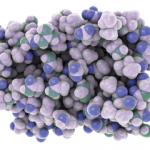Different Types of SLE
As with adult SLE, both the clinical manifestations and pathogenesis of cSLE are heterogeneous. WGS reveals a monogenic (familial) underlying cause in less than 15% of patients with cSLE, and about 130 common allelic variants are associated with the risk of developing SLE.4 Interestingly, studying monogenic lupus has enabled the discovery of different pathways that induce the SLE phenotype.4,5
SLE can arise from deficiencies, among others, in the complement/immune complex removal system or intra- and extra-cellular nucleic acid degradation system. Loss of B cell tolerance due to intrinsic B cell defects is also a major contributor. Dr. Pascual explained, “The majority of the genetic mutations identified so far that predispose to early onset SLE result in an increase in IFN pathway activity. Overall, however, different pathways upstream of interferon can induce the SLE phenotype.”6
By monitoring the immune systems of patients to identify cell types and gene expression patterns that correlate with disease flares and remissions, different groups of patients with cSLE have been identified.7 Future studies aim to elucidate differences between these groups, especially as it pertains to using this information to design clinical trials and apply personalized therapies to eventually test the value of cellular and transcriptional biomarkers.
Why Are These Data Important?
“Data like [these are] important because industry is developing drugs to block a wide variety of targets within the pathways that have been identified through genomics and immune monitoring technologies,” Dr. Pascual said. “Work like this is opening the possibility for much more personalized therapies or combinations of therapies. And we need to figure out in which patients these may work in order to avoid cumulative or irreversible damage.”
In Sum
Novel techniques offer hope for developing personalized therapies that are tailored to a person’s specific genetic and biological makeup, hopefully leading to better outcomes. “We are trying to classify our patients into the right molecular group. The better we characterize their underlying immune dysregulation, the more accurately and hopefully successfully we can treat them,” Dr. Pascual concluded.
 Samantha C. Shapiro, MD, is a clinician educator who is passionate about the care and education of rheumatology patients. She writes for both medical and lay audiences and practices telerheumatology.
Samantha C. Shapiro, MD, is a clinician educator who is passionate about the care and education of rheumatology patients. She writes for both medical and lay audiences and practices telerheumatology.
References
- Bennett L, Palucka AK, Arce E, et al. Interferon and granulopoiesis signatures in systemic lupus erythematosus blood. J Exp Med. 2003 Mar 17;197(6):711–723.
- Morand EF, Furie R, Tanaka Y, et al. Trial of anifrolumab in active systemic lupus erythematosus. N Engl J Med. 2020 Jan 16;382(3):211–221.
- Jayne D, Rovin B, Mysler E, et al. Anifrolumab in lupus nephritis: Results from second-year extension of a randomised phase II trial. Lupus Sci Med. 2023 Aug;10(2):e000910.
- Omarjee O, Picard C, Frachette C, et al. Monogenic lupus: Dissecting heterogeneity. Autoimmun Rev. 2019 Oct;18(10):102361.
- Qin Y, Ma J, Vinuesa CG. Monogenic lupus: Insights into disease pathogenesis and therapeutic opportunities. Curr Opin Rheumatol. 2024;36(3):191–200.
- Vinuesa CG, Shen N, Ware T. Genetics of SLE: Mechanistic insights from monogenic disease and disease-associated variants. Nat Rev Nephrol. 2023 Sep;19(9):558–572.
- Banchereau R, Hong S, Cantarel B, et al. Personalized immunomonitoring uncovers molecular networks that stratify lupus patients. Cell. 2016 Apr 21;165(3):551–565.

